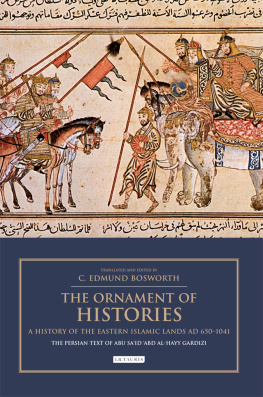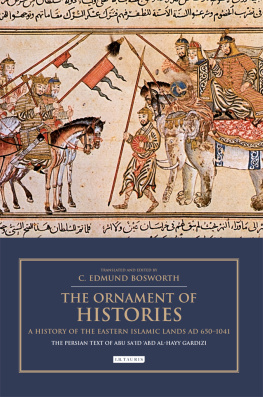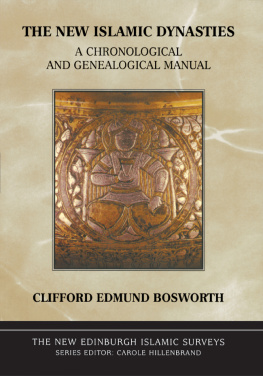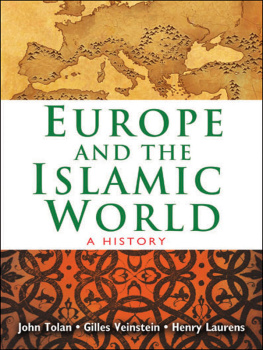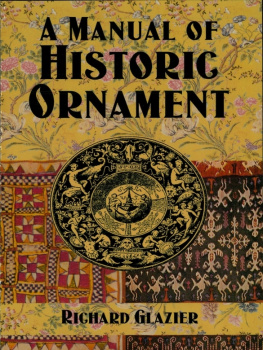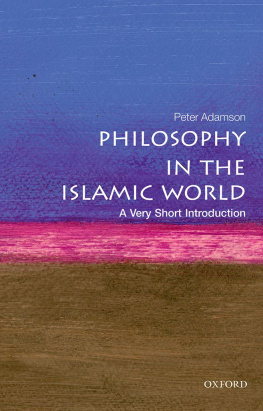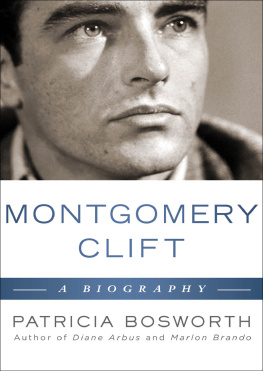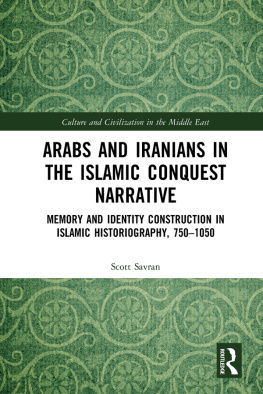Bosworth C. Edmund - The Ornament of Histories: a History of the Eastern Islamic Lands AD 650-1041
Here you can read online Bosworth C. Edmund - The Ornament of Histories: a History of the Eastern Islamic Lands AD 650-1041 full text of the book (entire story) in english for free. Download pdf and epub, get meaning, cover and reviews about this ebook. year: 2011, publisher: I. B. Tauris, genre: Detective and thriller. Description of the work, (preface) as well as reviews are available. Best literature library LitArk.com created for fans of good reading and offers a wide selection of genres:
Romance novel
Science fiction
Adventure
Detective
Science
History
Home and family
Prose
Art
Politics
Computer
Non-fiction
Religion
Business
Children
Humor
Choose a favorite category and find really read worthwhile books. Enjoy immersion in the world of imagination, feel the emotions of the characters or learn something new for yourself, make an fascinating discovery.
- Book:The Ornament of Histories: a History of the Eastern Islamic Lands AD 650-1041
- Author:
- Publisher:I. B. Tauris
- Genre:
- Year:2011
- Rating:3 / 5
- Favourites:Add to favourites
- Your mark:
- 60
- 1
- 2
- 3
- 4
- 5
The Ornament of Histories: a History of the Eastern Islamic Lands AD 650-1041: summary, description and annotation
We offer to read an annotation, description, summary or preface (depends on what the author of the book "The Ornament of Histories: a History of the Eastern Islamic Lands AD 650-1041" wrote himself). If you haven't found the necessary information about the book — write in the comments, we will try to find it.
Bosworth C. Edmund: author's other books
Who wrote The Ornament of Histories: a History of the Eastern Islamic Lands AD 650-1041? Find out the surname, the name of the author of the book and a list of all author's works by series.
The Ornament of Histories: a History of the Eastern Islamic Lands AD 650-1041 — read online for free the complete book (whole text) full work
Below is the text of the book, divided by pages. System saving the place of the last page read, allows you to conveniently read the book "The Ornament of Histories: a History of the Eastern Islamic Lands AD 650-1041" online for free, without having to search again every time where you left off. Put a bookmark, and you can go to the page where you finished reading at any time.
Font size:
Interval:
Bookmark:

C. EDMUND BOSWORTH (19282015) was a Fellow of the British Academy, an Honorary Member of the Hungarian Academy of Sciences and, until his retirement, Professor of Arabic Studies at the University of Manchester. He was the British Editor of the second edition of the Encyclopaedia of Islam, and wrote numerous books and articles on the history, culture and literature of the Arabic, Persian and Turkish lands of the Middle East and Central Asia in the pre-modern period. For many years he was also the editor of Iran, the journal of the British Institute of Persian Studies. He was the recipient of the biennial Giorgio Levi Della Vida Award at the University of California, Los Angeles.
This is an excellent annotated translation of this important historical text by a most qualified scholar.
Farhad Daftary,
Co-Director and Head of the Department of Academic
Research and Publications, Institute of Ismaili Studies.
All in all this is a most useful publication which makes available one of the earliest examples of Persian historical literature and most important sources for the history of the Khurasan.
The Bulletin of the School of Oriental and African Studies

To the memories of Vladimir Minorsky (18771966) and Sir Gerard Clauson (18911974), who were always ready to share their expert knowledge on the Iranian and Turkish worlds with a much younger scholar.
CONTENTS
Having completed, after some eight years work on it, my translation of and commentary on Bayhaqs Trkh-i Masd (see below, pp. 910), it seemed to me worthwhile attempting a similar task one fortunately less arduous for the other contemporary source for the sultanates of Masd and his immediate successors in Ghazna, the Zayn al-akhbr of Gardz. Gardzs section on the Ghaznavids actually forms part of an extended history of the successive rulers in Khurasan and the Islamic East from early caliphal days until the authors own time. The translation given here is accompanied by a commentary, one which is, however, on a less detailed scale than that provided for the Bayhaq translation; nevertheless it will, I trust, be adequate for the comprehension of Gardzs narrative and its place in the general history of the Eastern Islamic lands. Ideally, the task of making available in translation the contemporary sources on the early Ghaznavids should be completed by a version of al-Utbs recounting of the origins of the Ghaznavid dynasty and the first two-thirds of Mamds reign, in his al-Tarkh al-yamn; but tackling al-Utbs florid and discursive Arabic must be left to a future labourer in the Eastern Islamic vineyard.
It is especially fitting that this book should appear in the publication series of the British Institute of Persian Studies, for whose journal Iran I have acted as Co-Editor for over forty years (surely a record in journal editorship!), and I am grateful for the encouragement of colleagues at the Institute in putting the present book together.
Various other colleagues have helped me by providing items of information, sending me copies of books and articles, etc.; I am much indebted to them all. They include: Mr Mel Dadswell (Chudleigh Knighton, Devon); Dr Farhad Daftary (Institute of Ismaili Studies, London); Professor Geert Jan Van Gelder (Oxford University); Professor Peter Golden (Rutgers University, N.J.); Dr Pavel Lurye (sterreichische Akademie der Wissenschaften, Vienna); Professor Nicholas Sims-Williams (School of Oriental and African Studies, London); Dr Luke Treadwell (Oxford University); and M. tienne de la Vaissire (ENS Laboratoire darchologie, Paris). These are specifically thanked in the appropriate places, but I am especially obliged to Dr Daftary and to Mr Franois de Blois (School of Oriental and African Studies, London) who have advised on certain problematic words and passages of Gardzs text. But as always, the buck stops with the author himself, to whose account any imperfections must be laid.
C. Edmund Bosworth
Castle Cary, Somerset
February 2009
| AEMAe | Archivum Eurasiae Medii Aevi (Wiesbaden) |
| AOHung | Acta Orientalia Academiae Scientarum Hungaricae (Budapest) |
| BGA | Bibliotheca Geographicorum Arabicorum (Leiden) |
| BSOAS | Bulletin of the School of Oriental and African Studies (London) |
| CAJ | Central Asiatic Journal (The Hague, Wiesbaden) |
| CHIr | The Cambridge History of Iran (Cambridge) |
| EI2 | Encyclopaedia of Islam, second edition (Leiden) |
| EIr | Encyclopaedia Iranica (New York) |
| GMS | E.J.W. Gibb Memorial Series (Leiden, London) |
| H | abbs text of the Zayn al-akhbr |
| IQ | Islamic Quarterly (London) |
| Iran JBIPS | Iran, Journal of the British Institute of Persian Studies (London) |
| Isl. | Der Islam (Strassburg-Berlin, Leipzig-Berlin) |
| IsMEO | Istituto Italiano per il Medio ed Estremo Oriente (Rome) |
| JESHO | Journal of the Economic and Social History of the Orient (Leiden) |
| JRAS | Journal of the Royal Asiatic Society (London) |
| M | Rizda Maliks text of the Zayn al-akhbr |
| MW | The Muslim World (Hartford, Conn.) |
| N | Nazims text of the Zayn al-akhbr |
| RSO | Revista degli Studi Orientali (Rome) |
| SBWAW | Sitzungsberichte der Kaiserlichen Akademie der Wissenschaften zu Wien (Vienna) |
| St.Ir. | Studia Iranica (Paris) |
The author of the Ornament of Histories, Ab Sad Abd al-ayy b. al-ak b. Mamd Gardz, is a most shadowy figure. He must have been connected with the early Ghaznavid court or bureaucracy, and he claims to have been present at many significant events involving the military exploits of his masters (see below), although it is strange that neither of his fellow-historians, Ab Nar Utb (who was admittedly of an older generation, probably dying in the last decade of Sultan Mamds reign), nor Abu l-Fal Bayhaq (who died in 470/1077, hence may well have been a fairly exact contemporary of Gardz) mentions him. It seems very improbable that he did not know Bayhaq at least, working as Gardz obviously did at the Ghaznavid court.
The Ornament of Histories is a mlange of information, historical, geographical and ethnographical such as would be of interest to the ruling official and scholarly classes of the Eastern Iranian world; if for nothing else, it would be noteworthy as the first work in New Persian to combine general history with specifically dynastic history. The Turkish ethnic origins of the house of Sebktegin and the raids into northern India of the Amirs would explain Gardzs appending sections on the Turkish tribes of Inner Asia and Eastern Europe and on the festivals and religious and philosophical sects of the Indians to the more strictly historical part of the book. This historical part plunges in medias res, since a presumed preface or exordium has been lost from the manuscripts (on which, see below), with the legendary Persian kings, the Arsacids and the Sasanid emperors. It continues with a sketchy account of the Islamic caliphs up to Gardzs contemporary al-Qim (acceded in 422/1031) until the author gets to what obviously interested him most, the history of the Arab governors in the East from Abdallh b. mir (governor of Basra and the East 2944/64964) onwards and the subsequent rulers there, still nominally agents of the caliphs but in practice increasingly independent. After dealing in some detail with the events surrounding the fall of Umayyad rule in Khurasan, the rise and career of Ab Muslim, and the establishment of the Abbasid Revolution there, the story of the successive governors continues till the time of the civil war between Hrn al-Rashds sons al-Amn and al-Mamn, with the latters eventual victory organised from his base in Khurasan. Al-Mamns rule merges into sections on the Tahirid governors in Khurasan, the Saffarid brothers Yaqb and Amr b. Layth, the Samanid amirs of Transoxania and Khurasan, and the early Ghaznavids.
Font size:
Interval:
Bookmark:
Similar books «The Ornament of Histories: a History of the Eastern Islamic Lands AD 650-1041»
Look at similar books to The Ornament of Histories: a History of the Eastern Islamic Lands AD 650-1041. We have selected literature similar in name and meaning in the hope of providing readers with more options to find new, interesting, not yet read works.
Discussion, reviews of the book The Ornament of Histories: a History of the Eastern Islamic Lands AD 650-1041 and just readers' own opinions. Leave your comments, write what you think about the work, its meaning or the main characters. Specify what exactly you liked and what you didn't like, and why you think so.

